
94% of researchers rate our articles as excellent or good
Learn more about the work of our research integrity team to safeguard the quality of each article we publish.
Find out more
ORIGINAL RESEARCH article
Front. Environ. Sci., 19 September 2023
Sec. Environmental Economics and Management
Volume 11 - 2023 | https://doi.org/10.3389/fenvs.2023.1220325
This article is part of the Research TopicAir Pollution as a Risk Factor Affecting Human Health and Economic CostsView all 18 articles
 Anna Jasińska-Biliczak1*
Anna Jasińska-Biliczak1* Eugene Ikwuwunna2,3
Eugene Ikwuwunna2,3Air pollution is a multidisciplinary research field, which affects sustainable development (SD) and Sustainable Development Goals (SDGs). Its multi-level cause and effect shows the direct influence of air pollution on human health, standards and costs of living, health treatment, and the economies of states. Poor air quality, as an SDG factor, may affect both lower wellbeing and economic growth. As developed economies have faced problems due to poor air quality, they have worked out solutions based on their technological engagement. However, emerging economies are still facing poor air quality as a main problem affecting their economic growth. The particulate matter factor, according to the air quality study, was used as the basis for comparative and statistical research. The findings of the study indicate that air pollution causes a serious impact relating to workforce productivity, absence from work, mortality, and even lower crop yields. There is an obvious research gap in the investigated field of comparative studies considering air pollution as an SD factor, understood as an economic concept. Therefore, the current study is proposed to fulfil this gap, contribute to the knowledge base of the factors affecting human development, and expand the statistical data based on the findings from a comparison between Poland and Germany on their performance in air quality tests. This is a novel approach pointing to air pollution as the proposed focus of research for the realisation of SDGs.
The relationship between economic development and environmental pollution has been the subject of intense research (Fodha and Zaghdoud, 2010; Landrigan, 2016; Tan et al., 2021; Torkayesh et al., 2022). In addition, policymakers have long attempted to promote and sustain economic growth (Sultana et al., 2022) as the basis for the stable and prosperous development of societies. Furthermore, for the development to be sustainable, it must consider social, ecological, and economic issues; the basis of living and non-living resources; and the long- and short-term benefits and drawbacks of alternative actions (Sustainable Development: Evaluation of the Concept and its Economic, Ethical, Political and Cultural Dimension, n.d.). This is typically thought to operate at the crossroads of environmental, economic, and social concerns.
Economic growth, based on the concept of sustainable development, enables emerging economies to gradually close the gap with more developed economies. Activities that develop an economy in transition may include increasing the standards of living, developing a competitive industrial and commercial base, and improving the infrastructure. Economic growth may also consider access to resources, such as solar energy, clean soil, and air. Moreover, developed economies are not free from the challenges of Sustainable Development Goals (SDGs)—they still reduce the influence of their economics on the natural environment.
Agenda 2030 of the SDGs of the United Nations (Sustainable Development Goals, 2022a) points to goals such as Goal 3, which aims at improving healthcare and wellbeing; Goal 6, which aims at improving access to clean water and sanitation; Goal 8, which is concerned with decent work and economic growth; Goal 10, which aims at reducing equalities; Goal 12, which is regarding responsible consumption and production; and Goal 13, which emphasises climate action for achieving sustained economic growth. Creativity, know-how, technology, and financial resources from all societies are needed to achieve SDGs in every context (Sustainable Development Goals. The SDGs in action. Sustainable Development Goals, 2023). Economic development is not promoted by human or technological capital; instead, it is fuelled by natural resources (Rahim et al., 2021). Furthermore, by 2030, SDG 3.9 aims at substantially reducing the morbidity, mortality, and illnesses caused by hazardous substances and pollution and contamination of air, water, and soil (UNDP, 2022b).
In the European Union, air pollution is considered to be the greatest hazard to the health of the EU residents (Widera et al., 2022). According to Dr Maria Neira, WHO Director, Department of Environment, Climate Change and Health, air pollution is one of the world’s biggest public health issues (WHO, 2022). Poisonous air may affect the proper functionality of the immune system and increase the risk of chronic illnesses. Furthermore, it causes vast comprehensive socio-economic disruption, direct and indirectly, positive and negative effects on the environment, like reduction in the water and air quality, ecological restoration, and noise reduction (Chakraborty and Maity, 2020). Table 1 presents the air pollution levels in the two countries examined.
This study aims to formulate a new direction for the realisation of SDGs through an investigation of the role of air pollution as a socio-economic factor in the environmental dimension of sustainable development economic theory. It contemplates air pollution as a factor that influences welfare and has economic costs. However, this exploratory attempt is limited to two countries (Germany and Poland) and is only concerned with data for the year 2020. The results add to the economic knowledge of the development of sustainable development as a concept, especially its environmental dimensions and best practices. Furthermore, this study aims to provide knowledge of current trends in both emerging and developed economies; however, it may be limited by the specificity of the economies on which it focused during the research. The conclusions show that there is a need to conduct research in other economies to fully recognise this problem.
Sustainable development means different things to different people, such as ecologists, environmental planners, economists, and activists. The discussion on sustainable development is partly interesting because the concept has been borrowed from both natural and social sciences (Redclift, 1991). The literature indicates that different economies have different policies and standards, particularly related to the environment. Developed economies typically adopt stricter environmental control policies and advanced technologies to reduce environmental pollution (Abdouli and Hammami, 2017). The extant body of literature concerning air pollution can be divided into the following areas: sustainable development as a socio-economic concept and air pollution along an environmental dimension.
Sustainable development is a resource-use pattern that attempts to meet human needs while maintaining the environment; therefore, these needs can be addressed not just now but also in the future. The literature highlights a crucial matter concerning the future of humans (Zhao et al., 2020). As an economic concept, sustainable development is characterised by three dimensions: economic, social, and environmental. Integrating these into public policies presents specific challenges at every stage of the policy cycle (ESCAP and Scientific, 2015). Figure 1 presents sustainable development using the intersecting circle and concentric circle approaches.
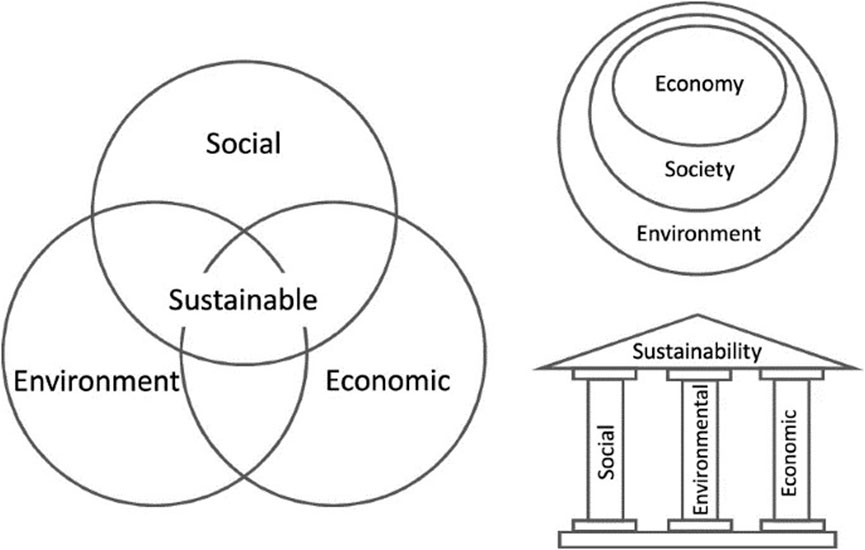
FIGURE 1. Representation of sustainability as three intersecting circles and its alternative depictions using literal pillar and a concentric circle approach. Source: Three pillars of sustainability: in search of conceptual origins (Purvis et al., 2019).
Thus, air pollution can be classified as an environmental factor. According to the literature, air quality is a major environmental concern because of rapid changes in pollutant emissions driven by complex and intensive human activities (Tan et al., 2021). In addition to climate change, air pollution and quality are key challenges for cities globally and have significant impact on human health and economic development (Liu et al., 2019). The phenomenon has also been linked to environmental and population health (Watt et al., 2015; Shindell et al., 2017). The description of air pollution has gradually developed to be based on the physical and chemical characteristics of specific pollutants, and the focal point has gradually shifted from single to multiple contaminants (Dominici et al., 2010; Carvalho et al., 2019). Many developed countries with superior air quality have implemented pollution control measures, while developing countries with large populations are entering or about to enter the stage of severe air pollution (Han et al., 2018). Table 2 presents the Global Burden of Diseases (GBD) 2017 risk factor hierarchy based on air pollution.
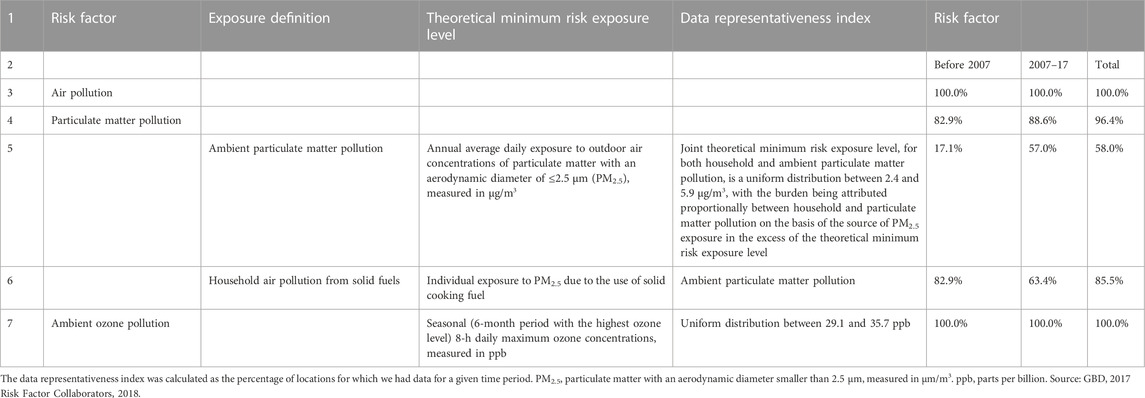
TABLE 2. GBD 2017 risk factor hierarchy and its accompanying exposure definitions, theoretical minimum risk exposure levels, and data representativeness index for each risk factor, pre-2007, 2007–17, and the total (across all years)—air pollution.
Reducing air pollution, including greenhouse gas (GHG) emissions originating from the extensive use of fossil fuels, is critical for European countries to improve their environment and achieve carbon neutrality by the middle of this century. To optimally reduce air pollutants and mitigate climate change, national and European Union level regulations and international agreements, such as the SDGs, Kyoto Protocol, and Paris Climate Agreement, must be included in these strategies (Torkayesh et al., 2022). Understanding the extent to which air pollution influences the process of achieving the SDGs may help estimate the benefit of reducing air pollution, so as to improve the attempts at sustainable development and for evaluating the necessity and urgency required to reduce air pollutants and, thus, improve air quality (Zhao et al., 2020). As a large number of people are adversely affected by pollution, the following question arose: “Should environmental concerns not encompass social concerns?” Consequently, not only have the studies in environmental and social fields begun to dovetail, but the study of environmental economics itself has emerged (Rogers et al., 2012).
First, a desk research was conducted. The data used as the base of the research were secondary and included the environmental indicators generated from the 2020 Organisation for Economic Cooperation and Development (OECD). As the comparative method was chosen to verify the hypotheses and the practical aim of the study was to compare emerging and developed economies, Poland and Germany were chosen for analysis. The statistical method, such as the multiple correlation test, was used.
From the aggregate Air Quality Index (AQI), based on the combined effects of five criteria pollutants (CO, SO2, NO2, O3, and PM10) and considering European standards, the particulate matter pollutant, as the most common and measured pollutant in most countries, was chosen for analysis. The usefulness of this factor has been confirmed in previous studies (Zeger et al., 2000; Beloconi et al., 2016; Stafoggia et al., 2017).
The literature indicates that Sweden, Latvia, France, Lithuania, Hungary, and Italy were ranked as the top six countries with the lowest emissions. However, Finland, Poland, the Czech Republic, Luxembourg, and Estonia had the lowest overall rankings and highest per capita emissions (Torkayesh et al., 2022). The rankings influenced the choice of countries (economies) to be compared: Poland is an emerging economy with one of the highest emissions, and Germany is a developed economy focussing on green economy development. In addition, strong economic bonds exist between these two economies.
The proposed methodology consists of the following steps: desk research and data analysis using comparative and statistical methods, in which the use of public statistics data is justified.
To investigate air pollution as a socio-economic factor and to examine its role in the environmental dimension of the sustainable development economic theory concept, based on the aforementioned discussion, the following hypothesis (H) was formulated:
H: Air pollution plays a crucial role in realising SDGs and allows developing sustainable development as an economic concept.
In addition, the following supporting hypotheses were established:
H1:. Air pollution is a crucial environmental factor, which helps formulate new directions for SDGs’ realisation.
H2:. The environmental dimension of sustainable development is becoming increasingly important and is strongly related to healthcare costs.
H3:. Air pollution has serious economic implications, particularly at the national level.
Here, we consider the impact of generated waste and its collection on the economic, social, and environmental dimensions and the waste collected and treated by or for municipalities. It covers wastes from trade and commerce, hospitals, office buildings, and households, including bulky waste, garden waste, street sweepings, market cleansing waste, and contents of litter containers. These exclude wastes from municipal sewage networks and treatment, as well as waste from construction and demolition activities. This indicator is measured in thousands of tonnes and kilogrammes per capita (OECD, Environmental Performance Reviews: Finland, 2021) examined.
At the same time, the purpose of the air, GHG emissions, and CO2 data was to determine the gross direct emissions from human activities in both Poland and Germany. Figure 2 shows the indicators of CO2 emissions for both countries during the same period.
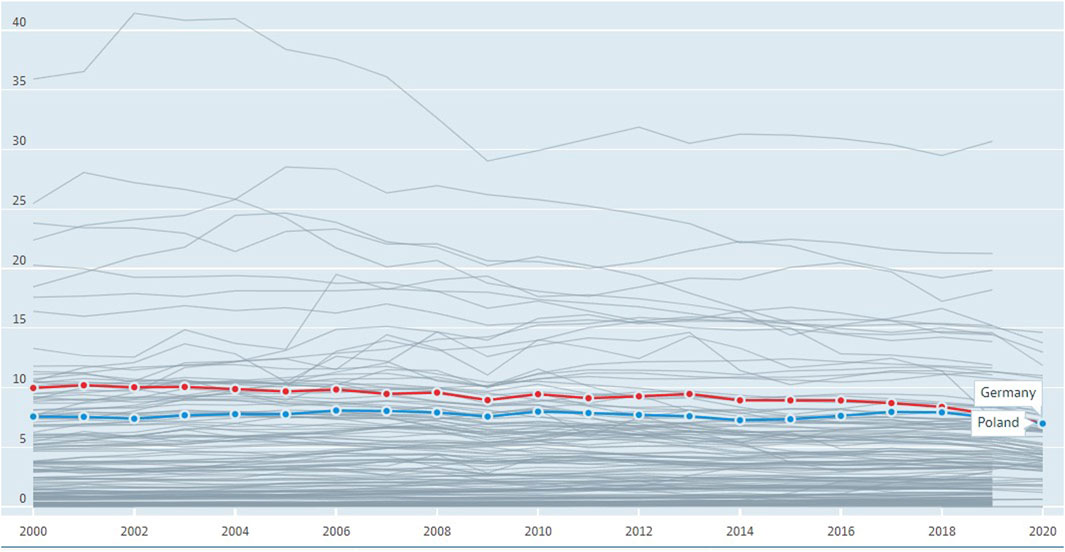
FIGURE 2. Indicators of CO2 emissions in Germany and Poland during 2000–2020. Source: OECD data indicators for CO2 emissions.
Figure 2 shows the position of examined countries at the background of other OECD countries (grey lines).
The data expressed in CO2 equivalents refer to gross direct emissions from human activities. CO2 refers to the gross direct emissions from fuel combustion only, and these data are provided by the International Energy Agency (IEA); air and GHG emissions are measured in thousand tonnes, tonnes per capita, or kilogrammes per capita, except for CO2, which is measured in million tonnes and tonnes per capita (Air and emissions, 2022). For a comparative study, we also compared the data on population exposure to fine particulates in these two countries. This comparison is presented as a percentage in Table 3.
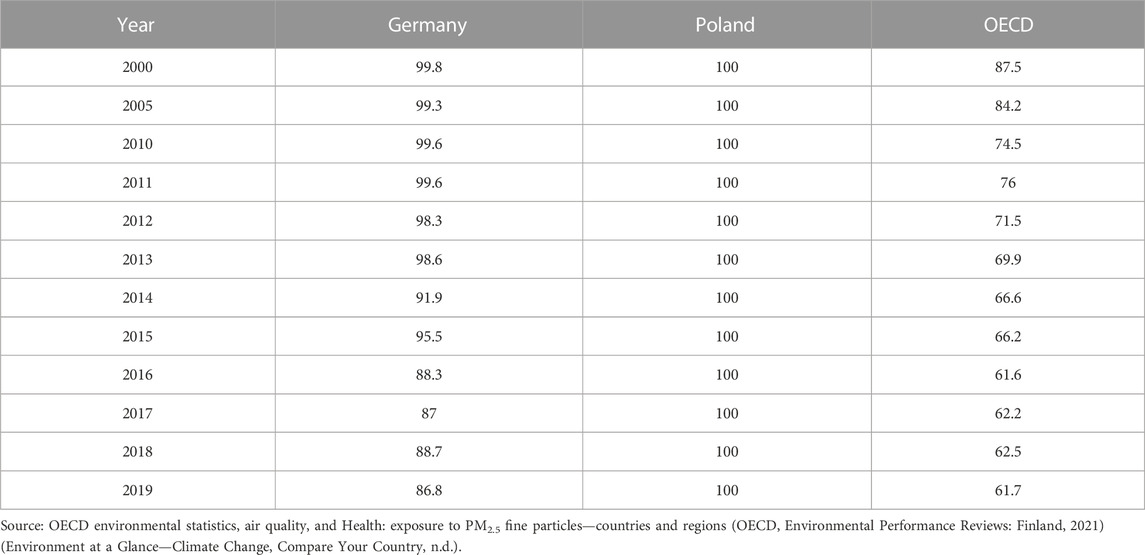
TABLE 3. Air pollution exposure of the population of Poland and Germany, at the OECD background, exposed to fine particulates (PM2.5), with concentrations exceeding the WHO guidelines (10 μg per cubic metre) in the percentage of the population in years 2000, 2005, and 2010–2019.
These data are used to find out the percentage of the population that is being exposed to fine particulate (PM2.5) concentrations exceeding WHO guidelines (10 μg per cubic metre) and its effect on the population in Poland and Germany. It represents the percentage of the population exposed to fine particulate (PM2.5) in the air, which increases the risk of respiratory and cardiovascular diseases in particular. These data indicate the exposure of the population to fine particulate concentrations more than 10 μg/m3 and are expressed as annual averages.
The data reveal interesting observations. For example, the emerging economy (Poland) made no progress during the 20-year period, while OECD countries and the developed economy (Germany) made progress on this count during the same period. This is because the developed economy, Germany, made investments in research and development and new technologies, as well as green energy. The economic and social costs incurred by air pollution are mainly related to a shorter life expectancy (real and expected) and health disorders (also understood as healthcare social costs) in the emerging economy (Poland). The social cost of air pollution is also related to mortality, as shown in Table 4.
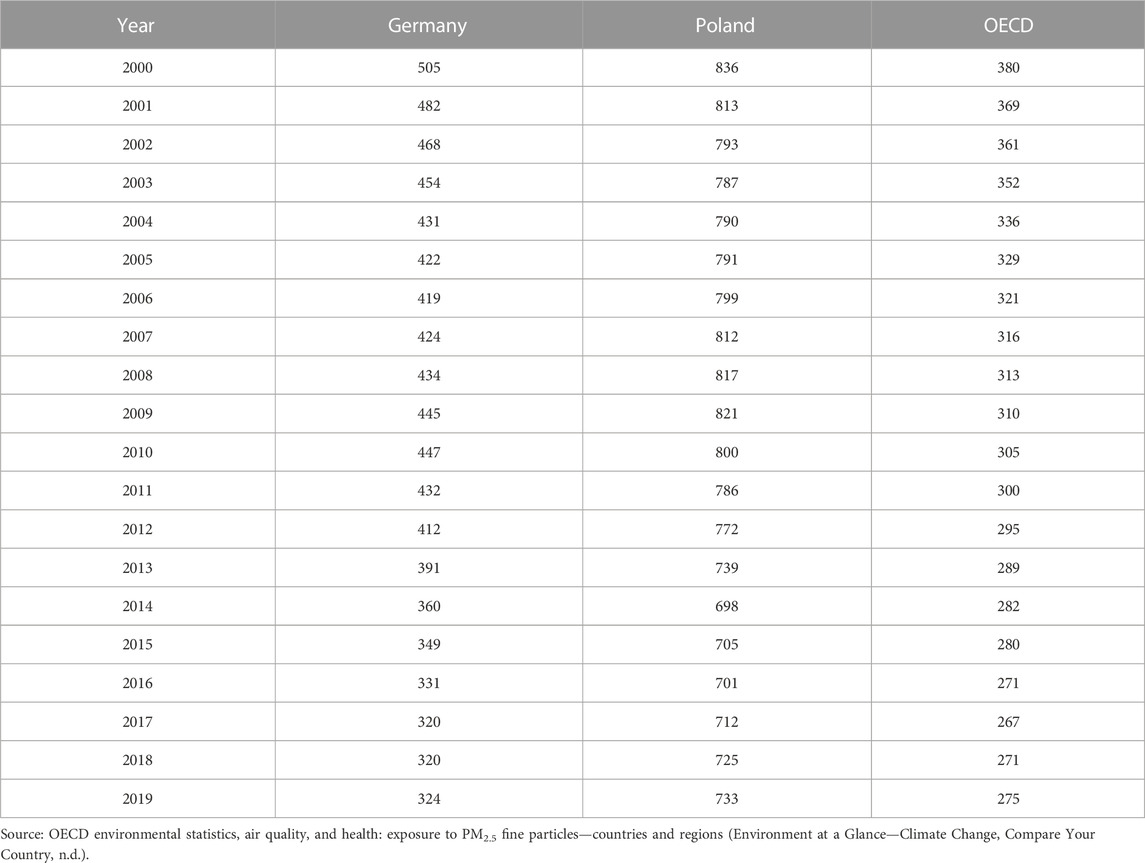
TABLE 4. Mortality attributed to exposure to fine particulates (PM2.5), with the annual deaths per million inhabitants during 2000–2019.
Figure 3 shows the welfare costs of mortality due to exposure to fine particulates.
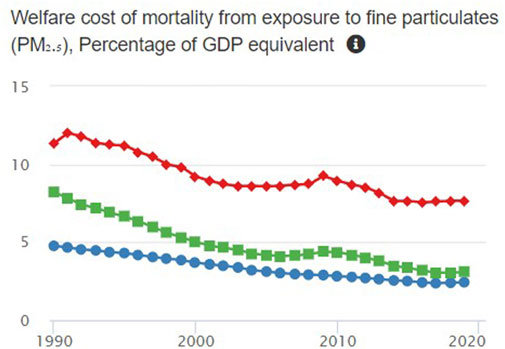
FIGURE 3. Welfare costs of mortality due to exposure to fine particulates in Poland and Germany for the period 1990–2020, as a percentage of GDP equivalent. Presented data are matched with the colours in the following order: Poland, Germany, and OECD overage. Source: OECD environmental statistics, air quality, and health: exposure to PM2.5 fine particles—countries and regions (Environment at a Glance—Climate Change, Compare Your Country, n.d.).
The air pollution effect is reflected in the mortality rate per 1,000,000 inhabitants. In 2019, the cost estimate of inhaled fine particulate matter that causes serious health issues, like respiratory and cardiovascular diseases, exerts a significant effect on children and elderly people, increasing their risk of heart diseases and stroke in particular, eventually leading to death. The cost estimate only represents premature mortalities and is calculated using the estimates of the value of a statistical life (VSL) and the number of premature deaths attributable to ambient particulate matter.
Here, the correlations between mortality and air pollution in Poland and Germany were examined. Table 5 shows welfare costs, mortality, and municipal waste.
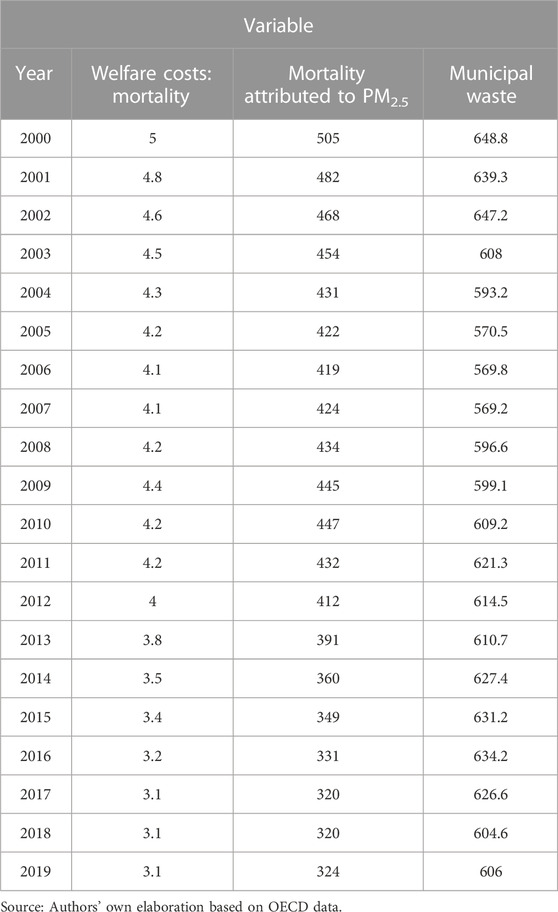
TABLE 5. Mortality, welfare costs, and municipal wastes of Germany (the developed economy) for the period 2000–2019.
The data were used to run multiple correlation tests of the following variables: welfare cost of mortality from exposure to fine particulates (PM2.5), mortality attributed to the exposure to fine particulates (PM2.5), and municipal wastes generated in Germany. Table 6 shows the correlation results.
The results of the correlation test showed that there was a significant positive correlation between the mortality attributed to exposure to fine particulates (PM2.5) and the welfare cost of mortality from exposure to fine particulates (PM2.5). Compared to that, municipal waste had a less significant positive correlation with both the welfare cost of mortality from exposure to fine particulates (PM2.5) and the mortality attributed to exposure to fine particulates (PM2.5). The same tests were conducted for Poland, an emerging economy, and the results are shown in Table 7.
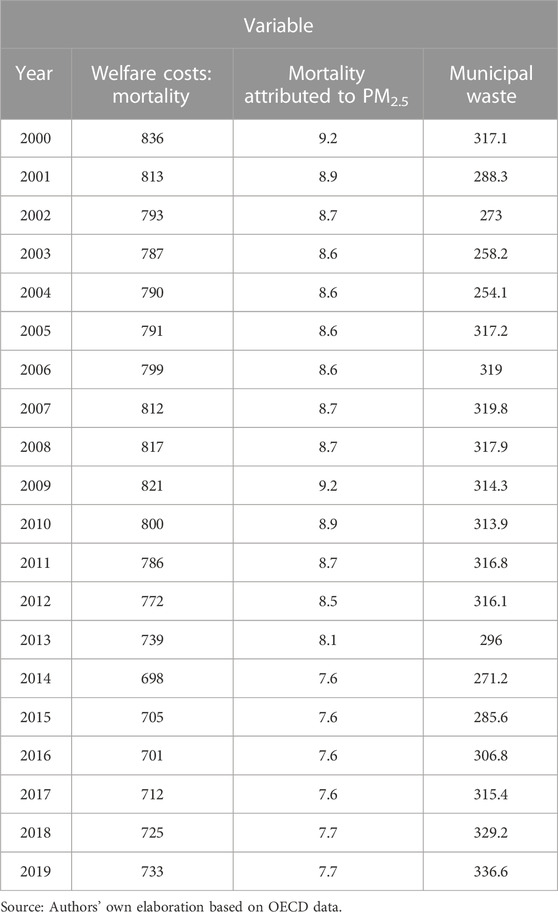
TABLE 7. Correlation test data of mortality, welfare costs, and municipal wastes in Poland (emerging economy) for the period 2000–2019.
The data were used to run multiple correlation tests of the following variables: welfare cost of mortality from exposure to fine particulates (PM2.5), mortality attributed to the exposure to fine particulates (PM2.5), and municipal wastes generated in Poland. Table 8 shows the correlation results.
The correlation tests showed a strong positive association between mortality attributed to fine particulate exposure (PM2.5) and the welfare cost of mortality from fine particulate exposure (PM2.5), whereas municipal wastes showed a less significant positive correlation. In addition, there was a slight negative correlation between the amount of municipal wastes generated and the cost of mortality due to fine particulate exposure.
In 2017, air pollution caused 4.9 million deaths worldwide according to the global burden of death (GBoD) (Stanaway et al., 2018). Owing to the diversity of its diameter and composition type, particulate matter may have multiple effects on the whole body of a person, especially on the cardiovascular and respiratory systems, such as systemic inflammation and oxidative stress, increase in blood pressure, and changes in serum metabolites (Wang et al., 2015; Goudarzi et al., 2018; Mirabelli et al., 2020).
The environmental, behavioural, and metabolic risks that drive injury and disease are the mechanisms through which public health efforts can most efficiently and effectively prevent health loss. Therefore, effective population health improvements require the understanding of not only the injuries and diseases that drive health burdens but also the risks that drive injury and diseases (Landrigan, 2016). Against the backdrop of increasingly diverse multi-contaminant air conditions, human welfare will be seriously threatened if air pollution cannot be scientifically and effectively quantified and properly controlled (Tan et al., 2021). The health effects of particulate matter in Italy have been widely investigated in multicentre projects, evaluating short-term associations between daily particulate matter concentrations and mortality/hospitalisations across several Italian cities (Biggeri et al., 2005). The research on France and Iran (Sicard et al., 2019) showed that long-term exposure to ambient PM2.5 and PM10 has substantially contributed to mortality and hospital admissions in the selected cities: non-accidental causes, cardiovascular diseases, respiratory diseases, and chronic obstructive pulmonary diseases caused approximately 8,200, 2,400, 540, and 220 deaths, respectively, in 2015; in addition, cardiovascular diseases and respiratory diseases caused 18,800 and 3,400 hospital admissions, respectively. A research, in a national cohort of approximately 2.5 million Canadians, covered pollution exposure and its associations with citizen mortality, which showed that exposure to PM2.5, alone, was not sufficient to fully characterise the toxicity of the atmospheric mix or to fully explain the risk of mortality associated with exposure to ambient pollution (Crouse et al., 2015). Increasing evidence suggests that long-term exposure to ambient air pollution is associated with death from cardiopulmonary diseases. A 2002 pilot study reported clear indications that traffic-related air pollution was related to cardiopulmonary mortality in a randomly selected sub-cohort of 5,000 older adults participating in an ongoing Netherlands Cohort Study (Brunekreef et al., 2009). Another study, which was part of the ESCAPE project, measured the concentrations of PM(2.5), PM(2.5) absorbance, PM(10), and PM (coarse) in 20 European study areas at 20 sites per area. Predictor variables (e.g., traffic intensity, population, and land-use) were evaluated to model the spatial variation in the annual average concentrations for each study area. Examination of influential factors and skewed variable distributions was essential for developing stable LUR models, which can be used to estimate air pollution concentrations at the home addresses of participants in the health studies involved in the ESCAPE project (Eeftens et al., 2023). The range and number of studies covered by these topics confirmed and underlined their importance.
For developing risk attribution for particulate matter pollution, the integrated exposure–response curves combine epidemiological data from ambient, household, secondhand, and active smoking sources to construct a risk curve for the full exposure range (Landrigan, 2016). Evidence suggests that exposure to PM2.5 might be mechanistically linked to type 2 diabetes through altered lung function, vascular inflammation, and insulin sensitivity (Rajagopalan and Brook, 2012).
Air pollution can affect businesses through reduced workforce productivity, absence from work, premature deaths, and lower crop yields. Air pollution negatively impacts the U.S. economy, costing the U.S. roughly 5% of its yearly gross domestic product (GDP) in damages ($790 billion in 2014) (Mirabelli et al., 2020). The highest costs were on account of early deaths, attributable to the exposure to fine particulate matter (PM2.5). While some PM2.5 in the atmosphere is due to the result of natural processes, such as forest fires or windblown dust, most damage from PM2.5 is related to human activities, most of which can be attributed to different sectors of the economy, such as manufacturing and agriculture. Combining damage with more traditional measures of economic production, such as GDP or gross value added, provides a more accurate picture of a sector’s full economic impact (Tschofen et al., 2019). In 2015, the WHO and OECD estimated that the economic cost of premature deaths and disabilities due to air pollution in Europe was close to 1.6 trillion USD. Air pollution takes its toll on the economy in several ways: it costs human lives, reduces people’s ability to work, affects vital products, such as food, damages cultural and historical monuments, reduces the ability of ecosystems to perform functions that societies need, and costs money in remediation or restoration (UNECE, 2023). With sustained economic growth, environmental pollution in China has become increasingly serious and displays certain regional differences. Economic growth, energy structure, and industrial pollution in China are spatially correlated, with different agglomeration areas in the spatial distribution. In terms of the temporal dimension, energy consumption and technological pollution effects in China have led to increased environmental pollution, while changes in the structural effect have indirectly improved the environmental situation (Zhang et al., 2020; Zhang et al., 2023). Research indicates that there is a gap between citizens and technologies, which requires the development of more interactive systems and improved citizen education based on the SDGs and air pollution levels (Jasińska-Biliczak, 2022). However, air quality is subjected to many observed and unobserved factors, with evident seasonal changes that may confound the potential impact of enacted policies. Simple before–after comparisons would fail to differentiate the policy impact from such confounding changes and may thus lead to biased and inconsistent results (Qin et al., 2023).
This study summarises a commonly used air pollution measure, which is particulate matter, and the economic consequences of air pollution in countries representing both emerging and developed economies. The sustainability of the integrated approach in the environment and society remains debatable (Fang et al., 2023). It contributes to the discussion on sustainable development as an economic concept for the practical realisation of SDGs. It also contributes to the discussion on the necessity of immediate action toward lowering the welfare cost of mortality due to exposure to polluted air. At the same time, it addresses the research gap regarding the impact of air pollution on economic costs in EU economies. However, the study has a limitation: it considers only two countries (Germany and Poland) and data for the year 2020.
This study assesses the environmental risk caused by air pollution across two representative countries. Poland and Germany had similar air quality and GHG emissions per capita in 2020. Germany had a score of 7.040, while Poland had a score of 6.980 (approximately 7.000 tonnes per capita). This was due to the lockdown measures to prevent COVID-19 from spreading, resulting in a positive effect of COVID-19 in the form of clean air, but only for a short time. Similarly, between 1990 and 2000, the percentage of population of Germany and Poland exposed to fine particles (PM2.5) was roughly the same, with Germany having 100%, 99.7%, and 99.8% of its population exposed and Poland having 100%, 100%, and 100% of its population exposed in 1990, 1995, and 2000, respectively. The findings show that pollution poses a high risk of causing negative health effects in both countries’ populations; however, there are differences between the emerging and developed economies, with developed economies having an advantage.
In contrast, both countries increased their municipal waste (in kilogrammes per capita) from 2019 to 2020. Germany produced twice as much waste as Poland at the same time. It follows that in Germany, the COVID-19 pandemic had a greater impact on waste management than that in Poland. In contrast, from 2000 to 2019, Germany’s air and GHG emissions of carbon dioxide (CO2) in tonnes per capita increased, whereas those of Poland decreased. Furthermore, from 2000 to 2019, Germany’s average population exposure to fine particulates (PM2.5) in micrograms per cubic metre decreased, while that of Poland increased. This means that people in Poland experienced more negative health effects than those in Germany.
Similarly, mortality due to fine particulate matter (PM2.5) was lower in Germany than that in Poland, with annual deaths per million inhabitants being lower in Germany than that in Poland. As a result, Poland had a higher rate of attributed mortality per million inhabitants than Germany. The most recent data of 2020 are not available yet; however, the study indicates that the mortality attributable to COVID-19 and environmental effects will increase. In 2019, Germany had an almost three times higher mortality rate due to exposure than Poland. In contrast, Germany’s welfare cost of mortality from fine particulate exposure (PM2.5), expressed as a percentage of GDP, was lower than that of Poland.
Moreover, mortality is a socio-economic factor associated with the concept of sustainable development. In addition, it is strictly connected to the environmental dimension of sustainable development because the state of the environment has a direct influence on the number of sick and dying people. It also generates an additional cost for the society, which has to bear these costs for the treatment of people.
Air quality and its influence on health, economically understood as both private and public goods, is the subject of the present study and discussions at different levels. The governments of Poland and Germany should take major steps toward a European green deal accord and zero-pollution policy.
The original contributions presented in the study are included in the article/Supplementary Material; further inquiries can be directed to the corresponding author.
Conceptualisation and methodology: AJ-B; analysis: AJ-B and EI; data curation: EI; writing—original draft preparation, review, and editing: AJ-B; visualisation and supervision: AJ-B. All authors contributed to the article and approved the submitted version.
This study received funding from the Polish Ministry of Education and Science (Grant Number: 000-6-69-0).
The authors would like to thank Editage (www.editage.com) for English language editing.
Author EI was employed by Cognizant Technology Solutions.
The remaining author declares that the research was conducted in the absence of any commercial or financial relationships that could be construed as a potential conflict of interest.
All claims expressed in this article are solely those of the authors and do not necessarily represent those of their affiliated organizations, or those of the publisher, the editors, and the reviewers. Any product that may be evaluated in this article, or claim that may be made by its manufacturer, is not guaranteed or endorsed by the publisher.
Abdouli, M., and Hammami, S. (2017). Investigating the causality links between environmental quality, foreign direct investment and economic growth in MENA countries. Int. Bus. Rev. 26 (2), 264–278. doi:10.1016/j.ibusrev.2016.07.004
Air, , and emissions, G. H. G. (2022). Air and climate. Berlin. Germany: OECD iLibrary. Available at: https://www.oecd-ilibrary.org/environment/air-and-ghg-emissions/indicator/english_93d10cf7-en (accessed on May 24, 2023).
Beloconi, A., Kamarianakis, Y., and Chrysoulakis, N. (2016). Estimating urban PM10 and PM2.5 concentrations, based on synergistic MERIS/AATSR aerosol observations, land cover and morphology data. Remote Sens. Environ. 172, 148–164. doi:10.1016/j.rse.2015.10.017
Biggeri, A., Baccini, M., Bellini, P., and Terracini, B. (2005). Meta-analysis of the Italian studies of short-term effects of air pollution (MISA), 1990–1999. Int. J. Occup. Environ. Health 11 (1), 107–122. doi:10.1179/oeh.2005.11.1.107
Brunekreef, B., Beelen, R., Hoek, G., Schouten, L., Bausch-Goldbohm, S., Fischer, P., et al. (2009). Effects of long-term exposure to traffic-related air pollution on respiratory and cardiovascular mortality in The Netherlands: The NLCS-AIR study. Res. Rep. Heal. Eff. Inst. 139, 5–71. discussion 73-89.
Carvalho, R. L., Lindgren, R., García-López, N., Nyambane, A., Nyberg, G., Diaz-Chavez, R., et al. (2019). Household air pollution mitigation with integrated biomass/cookstove strategies in Western Kenya. Energy Policy 131 (1), 168–186. doi:10.1016/j.enpol.2019.04.026
Chakraborty, I., and Maity, P. (2020). COVID-19 outbreak: Migration, effects on society, global environment and prevention. Sci. total Environ. 728, 138882. doi:10.1016/j.scitotenv.2020.138882
Crouse, D. L., Peters, P. A., Hystad, P., Brook, J. R., van Donkelaar, A., Martin, R. V., et al. (2015). Ambient PM 2.5, O 3, and NO 2 exposures and associations with mortality over 16 Years of follow-up in the Canadian census health and environment cohort (CanCHEC). Environ. Health Perspect. 123 (11), 1180–1186. doi:10.1289/ehp.1409276
Dominici, F., Peng, R. D., Barr, C. D., and Bell, M. L. (2010). Opinion: Protecting human health from air pollution: Shifting from a single-pollutant to a multipollutant approach. Epidemiology 21, 187–194. doi:10.1097/EDE.0b013e3181cc86e8
Eeftens, M., Beelen, R., de Hoogh, K., Bellander, T., Cesaroni, G., Cirach, M., et al. (2023). Environment at a glance - climate change compare your country. Available at: http://www.compareyourcountry.org/environment-climate-change/en/9//trendStatus//DEU+POL (accessed on May 24, 2023).
Epub 2018 Nov 8, (2019). Erratum in: Lancet. Lancet 393 (10167). 132. Erratum in: Lancet. 2019 Jun 22;393(10190):e44. PMID: 30496105; PMCID: PMC6227755.
Escap, U. N., and Scientific, C. (2015). Integrating the three dimensions of sustainable development: A framework and tools. Bangkok, Thailand: United Nations Economic and Social Commission for Asia and the Pacific. doi:10.13140/RG.2.1.1334.6325
Fang, Y. K., Wang, H. C., Fang, P. H., Liang, B., Zheng, K., Sun, Q., et al. (2023). Life cycle assessment of integrated bioelectrochemical-constructed wetland system: Environmental sustainability and economic feasibility evaluation. Resour. Conservation Recycl. 189 (1), 106740. doi:10.1016/j.resconrec.2022.106740
Fodha, M., and Zaghdoud, O. (2010). Economic growth and pollutant emissions in Tunisia: An empirical analysis of the environmental Kuznets curve. Energy Policy 38, 1150–1156. doi:10.1016/j.enpol.2009.11.002
Gbd, (2017). Global, regional, and national comparative risk assessment of 84 behavioural, environmental and occupational, and metabolic risks or clusters of risks for 195 countries and territories, 1990-2017: A systematic analysis for the global burden of disease study 2017. Lancet 10;392 (10159), 1923–1994. doi:10.1016/S0140-6736(18)32225-6
Goudarzi, F., Asgari, H., and Al-Raweshidy, H. S. (2018). Traffic-aware VANET routing for city environments—a protocol based on ant colony optimization. IEEE Syst. J. 13 (1), 571–581. doi:10.1109/JSYST.2018.2806996
Gražulevičienė, R., Heinrich, J., Hoffmann, B., Jerrett, M., Keidel, D., Hoek, G., et al. (2012). Development of land use regression models for PM(2.5), PM(2.5) absorbance, PM(10) and PM(coarse) in 20 European study areas; results of the ESCAPE project. Environ. Sci. Technol. 46 (20), 11195–11205. doi:10.1021/es301948k
Han, Y., Jiang, P., Dong, T., Ding, X., Chen, T., Villanger, G. D., et al. (2018). Maternal air pollution exposure and preterm birth in wuxi, China: Effect modification by maternal age. Ecotoxicol. Environ. Saf. 157, 457–462. doi:10.1016/j.ecoenv.2018.04.002
Jasińska-Biliczak, A. (2022). Smart-city citizen engagement: The answer to energy savings in an economic crisis? Energies 15 (23), 8828. doi:10.3390/en15238828
Landrigan, P. J. (2016). Air pollution and health. Lancet Public Health 2, e4–e5. doi:10.1016/S2468-2667(16)30023-8
Liu, Q., Baumgartner, J., de Foy, B., and Schauer, J. J. (2019). A global perspective on national climate mitigation priorities in the context of air pollution and sustainable development. City Environ. Interact. 1 (1), 100003. doi:10.1016/j.cacint.2019.100003
Mirabelli, M. C., Ebelt, S., and Damon, S. A. (2020). Air quality index and air quality awareness among adults in the United States. Environ. Res. 183, 109185. doi:10.1016/j.envres.2020.109185
Oecd Environmental Performance Reviews: Finland, (2021). OECD environmental performance reviews: Finland 2021. Finland: OECD Environmental Performance Reviews. doi:10.1787/19900090
Purvis, B., Mao, Y., and Robinson, D. (2019). Three pillars of sustainability: In search of conceptual origins. Sustain. Sci. 14, 681–695. doi:10.1007/s11625-018-0627-5
Qin, Z., Liang, Y., Yang, C., Fu, Q., Chao, Y., Liu, Z., et al. (2023). Externalities from restrictions: Examining the short-run effects of urban core-focused driving restriction policies on air quality. Transp. Res. Part D Transp. Environ. 119 (1), 103723. doi:10.1016/j.trd.2023.103723
Rahim, S., Murshed, M., Umarbeyli, S., Kirikkaleli, D., Afmad, M., Tufail, M., et al. (2021). Do natural resources abundance and human capital development promote economic growth? A study on the resource curse hypothesis in next eleven countries. Resour. Environ. Sustain. 4, 100018. doi:10.1016/j.resenv.2021.100018
Rajagopalan, S., and Brook, R. D. (2012). Air pollution and type 2 diabetes: Mechanistic insights. Diabetes 61 (12), 3037–3045. doi:10.2337/db12-0190
Rogers, P. P., Jalal, K. F., and Boyd, J. A. (2012). An introduction to sustainable development. Oxfordshire, United Kingdom: Earthscan.
Shindell, D., Borgford-Parnell, N., Brauer, M., Haines, A., Kuylenstierna, J. C. I., Leonard, S. A., et al. (2017). A climate policy pathway for near-and long-term benefits. Science 356 (6337), 493–494. doi:10.1126/science.aak9521
Sicard, P., Khaniabadi, Y. O., Perez, S., Gualtieri, M., and De Marco, A. (2019). Effect of O 3, PM 10 and PM 2.5 on cardiovascular and respiratory diseases in cities of France, Iran and Italy. Environ. Sci. Pollut. Res. 26, 32645–32665. doi:10.1007/s11356-019-06445-8
Stafoggia, M., Schwartz, J., Badaloni, C., Bellander, T., Alessandrini, E., Cattani, G., et al. (2017). Estimation of daily PM10 concentrations in Italy (2006–2012) using finely resolved satellite data, land use variables and meteorology. Environ. Int. 99, 234–244. doi:10.1016/j.envint.2016.11.024
Stanaway, J. D., Afshin, A., Gakidou, E., Lim, S. S., Abate, D., Abate, K. H., et al. (2018). Global, regional, and national comparative risk assessment of 84 behavioural, environmental and occupational, and metabolic risks or clusters of risks for 195 countries and territories, 1990–2017: A systematic analysis for the global burden of disease study 2017. Lancet 392 (10159), 1923–1994. doi:10.1016/S0140-6736(18)32225-6
Sultana, T., Dey, S. R., and Tareque, M. (2022). Exploring the linkage between human capital and economic growth: A look at 141 developing and developed countries. Econ. Syst. 46, 101017. doi:10.1016/j.ecosys.2022.101017
Sustainable Development, (2022a). Evaluation of the concept and its economic, ethical, political and cultural dimension. Shahid Lincoln - Academia.edu. (n.d.). Available at: https://www.academia.edu/35764414/Sustainable_Development_Evaluation_of_the_Concept_and_its_Economic_Ethical_Political_and_Cultural_Dimension (accessed on March 29, 2023).
Sustainable Development Goals (UNDP), (2023). The SDGs in action (UNDP). Available at: https://www.undp.org/sustainable-development-goals?gclid=Cj0KCQjwgLOiBhC7ARIsAIeetVDHhrnj1YGKG6ZvlmEveJbJshP_H56gILMg8cls15jodtMZvovaGswaAkX-EALw_wcB (accessed on April 29, 2023).
Tan, X., Han, L., Zhang, X., Zhou, W., Li, W., and Qian, Y. (2021). A review of current air quality indexes and improvements under the multi-contaminant air pollution exposure. J. Environ. Manag. 279, 111681. doi:10.1016/j.jenvman.2020.111681
Torkayesh, A. E., Alizadeh, R., Soltanisehat, L., Torkayesh, S. E., and Lund, P. D. (2022). A comparative assessment of air quality across European countries using an integrated decision support model. Socio-Economic Plan. Sci. 81, 101198. doi:10.1016/j.seps.2021.101198
Tschofen, P., Azevedo, I. L., and Muller, N. Z. (2019). Fine particulate matter damages and value added in the US economy. Proc. Natl. Acad. Sci. 116 (40), 19857–19862. doi:10.1073/pnas.1905030116
UNDP Human Development Reports (UNDP) (2022b). Human development index. Available at: https://hdr.undp.org/data-center/human-development-index#/indicies/HDI (accessed on April 13, 2023).
UNECE (2023). Air pollution and economic development. Available at: https://unece.org/air-pollution-and-economic-development (accessed on April 30, 2023).
Wang, S., Gao, B., Li, Y., Mosa, A., Zimmerman, A. R., Ma, L. Q., et al. (2015). Manganese oxide-modified biochars: Preparation, characterization, and sorption of arsenate and lead. Bioresour. Technol. 181, 13–17. doi:10.1016/j.biortech.2015.01.044
Watts, N., Adger, W. N., Agnolucci, P., Blackstock, J., Byass, P., Cai, W., et al. (2015). Health and climate change: Policy responses to protect public health. lancet 386 (10006), 1861–1914. doi:10.1016/S0140-6736(15)60854-6
Who, (2022). Billions of people still breathe unhealthy air: New WHO data. Available at: https://www.who.int/news/item/04-04-2022-billions-of-people-still-breathe-unhealthy-air-new-who-data (accessed on May 24, 2023).
Widera, K., Grabowski, J., and Smoliński, A. (2022). The application of statistical methods in the construction of a model for identifying the combustion of waste in heating boilers based on the elemental composition of Ashes. Sustainability 14 (18), 11178. doi:10.3390/su141811178
Zeger, S. L., Thomas, D., Dominici, F., Samet, J. M., Schwartz, J., Dockery, D., et al. (2000). Exposure measurement error in time-series studies of air pollution: Concepts and consequences. Environ. Health Perspect. 108 (5), 419–426. doi:10.1289/ehp.00108419
Zhang, J., Zhang, K., and Zhao, F. (2020). Spatial effects of economic growth, energy consumption and environmental pollution in the provinces of China—an empirical study of a spatial econometrics model. Sustain. Dev. 28 (4), 868–879. doi:10.1002/sd.2042
Zhang, Z., Hao, L., Linghu, Y., and Yi, H. (2023). Research on the energy poverty reduction effects of green finance in the context of economic policy uncertainty. J. Clean. Prod. 410 (1), 137287. doi:10.1016/j.jclepro.2023.137287
Keywords: sustainable development goals, air pollution, sustainable development, socio-economy, welfare, economic costs
Citation: Jasińska-Biliczak A and Ikwuwunna E (2023) New directions for the realisation of SDGs given the economic and welfare costs incurred by air pollution. Front. Environ. Sci. 11:1220325. doi: 10.3389/fenvs.2023.1220325
Received: 10 May 2023; Accepted: 30 August 2023;
Published: 19 September 2023.
Edited by:
Artur Badyda, Warsaw University of Technology, PolandReviewed by:
Kai Liu, Shandong Normal University, ChinaCopyright © 2023 Jasińska-Biliczak and Ikwuwunna. This is an open-access article distributed under the terms of the Creative Commons Attribution License (CC BY). The use, distribution or reproduction in other forums is permitted, provided the original author(s) and the copyright owner(s) are credited and that the original publication in this journal is cited, in accordance with accepted academic practice. No use, distribution or reproduction is permitted which does not comply with these terms.
*Correspondence: Anna Jasińska-Biliczak, YW5uYS5qYXNpbnNrYS1iaWxpY3pha0B1bmkub3BvbGUucGw=
Disclaimer: All claims expressed in this article are solely those of the authors and do not necessarily represent those of their affiliated organizations, or those of the publisher, the editors and the reviewers. Any product that may be evaluated in this article or claim that may be made by its manufacturer is not guaranteed or endorsed by the publisher.
Research integrity at Frontiers

Learn more about the work of our research integrity team to safeguard the quality of each article we publish.